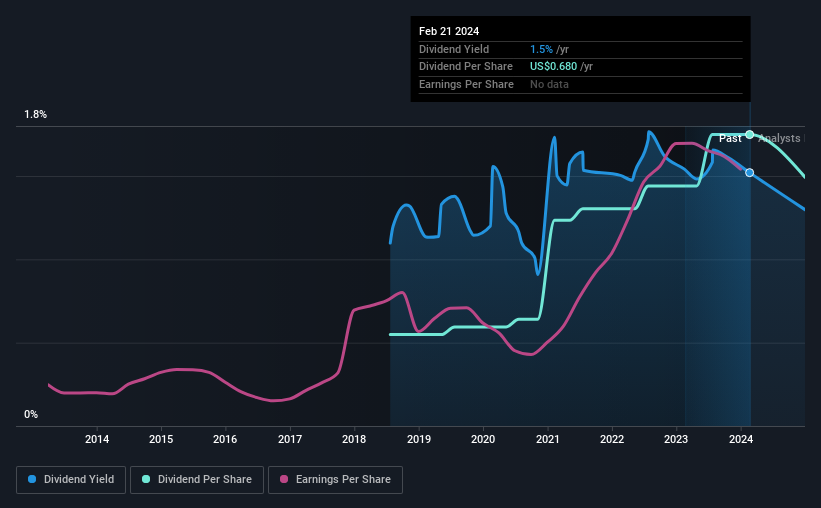There's A Lot To Like About Rush Enterprises' (NASDAQ:RUSH.A) Upcoming US$0.17 Dividend
Rush Enterprises, Inc. (NASDAQ:RUSH.A) is about to trade ex-dividend in the next 4 days. The ex-dividend date is one business day before a company's record date, which is the date on which the company determines which shareholders are entitled to receive a dividend. The ex-dividend date is of consequence because whenever a stock is bought or sold, the trade takes at least two business day to settle. In other words, investors can purchase Rush Enterprises' shares before the 26th of February in order to be eligible for the dividend, which will be paid on the 18th of March.
The company's next dividend payment will be US$0.17 per share. Last year, in total, the company distributed US$0.68 to shareholders. Looking at the last 12 months of distributions, Rush Enterprises has a trailing yield of approximately 1.5% on its current stock price of US$44.73. Dividends are an important source of income to many shareholders, but the health of the business is crucial to maintaining those dividends. That's why we should always check whether the dividend payments appear sustainable, and if the company is growing.
Check out our latest analysis for Rush Enterprises
If a company pays out more in dividends than it earned, then the dividend might become unsustainable - hardly an ideal situation. Rush Enterprises has a low and conservative payout ratio of just 14% of its income after tax. Rush Enterprises paid a dividend despite reporting negative free cash flow last year. That's typically a bad combination and - if this were more than a one-off - not sustainable.
Click here to see how much of its profit Rush Enterprises paid out over the last 12 months.
Have Earnings And Dividends Been Growing?
Businesses with strong growth prospects usually make the best dividend payers, because it's easier to grow dividends when earnings per share are improving. If earnings decline and the company is forced to cut its dividend, investors could watch the value of their investment go up in smoke. That's why it's comforting to see Rush Enterprises's earnings have been skyrocketing, up 23% per annum for the past five years.
Another key way to measure a company's dividend prospects is by measuring its historical rate of dividend growth. Since the start of our data, six years ago, Rush Enterprises has lifted its dividend by approximately 21% a year on average. It's exciting to see that both earnings and dividends per share have grown rapidly over the past few years.
Final Takeaway
Has Rush Enterprises got what it takes to maintain its dividend payments? Typically, companies that are growing rapidly and paying out a low fraction of earnings are keeping the profits for reinvestment in the business. Perhaps even more importantly - this can sometimes signal management is focused on the long term future of the business. Rush Enterprises ticks a lot of boxes for us from a dividend perspective, and we think these characteristics should mark the company as deserving of further attention.
On that note, you'll want to research what risks Rush Enterprises is facing. We've identified 2 warning signs with Rush Enterprises (at least 1 which makes us a bit uncomfortable), and understanding them should be part of your investment process.
A common investing mistake is buying the first interesting stock you see. Here you can find a full list of high-yield dividend stocks.
Have feedback on this article? Concerned about the content? Get in touch with us directly. Alternatively, email editorial-team (at) simplywallst.com.
This article by Simply Wall St is general in nature. We provide commentary based on historical data and analyst forecasts only using an unbiased methodology and our articles are not intended to be financial advice. It does not constitute a recommendation to buy or sell any stock, and does not take account of your objectives, or your financial situation. We aim to bring you long-term focused analysis driven by fundamental data. Note that our analysis may not factor in the latest price-sensitive company announcements or qualitative material. Simply Wall St has no position in any stocks mentioned.

